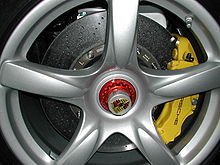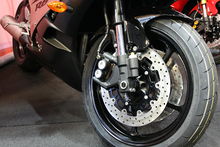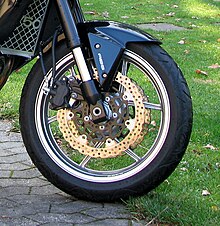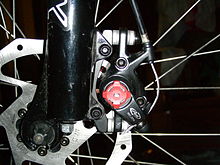Disc brake
The disc brake is a type of friction brake . In the embodiment as part of disc brake which is delay by one on the wheel hub mounted brake disc and the brake caliper lying brake with brake pads produced, in the embodiment as a full side and disk brake by pressing together of the brake discs. It is the most common type of construction in motor vehicles in the form of a partial disc brake in front of the drum brake and is also increasingly being used as a bicycle brake .
When braking, the kinetic energy of the vehicle is converted into heat by means of friction . The abrasion in the form of brake dust is a tribological wear phenomenon, which is particularly visible on the front wheels in the form of a layer of dust.
history
The inventor of the disc brake is considered to be the Briton Frederick W. Lanchester , who received a patent in 1902. The Lanchester disc brake was installed in Lanchester passenger cars from 1905 ; it was operated mechanically.
Joel H. Hendrick and Arthur H. Fay from Massachusetts received an American patent (No. 526317) on a disc brake for bicycles as early as 1894 . Also Elmer Ambrose Sperry to 1898 disc brakes are used for the constructed by him electric vehicle.
In 1940, Hermann Klaue , who later built bicycles, developed the fully-lined disc brake with self-reinforcement and a circumferential brake housing at Argus Motoren Gesellschaft , which supplied the fighter aircraft industry, and had it patented. Such brakes existed, for example, on the Arado Ar 96 and from 1942 on in the VI Tiger armored vehicle, which is to be regarded as the first mass-produced “motor vehicle” with disc brakes.
At the end of 1946 the concept for the Tucker '48 with disc brakes was presented, but the car only came onto the market in a small series with drum brakes. In 1950 , Crosley Motors temporarily installed aerospace disc brakes in a "hot shot". Lucas Girling launched the first disc brake for motorcycles in 1952. In Europe, the Jaguar C-Type racing car received four Dunlop disc brakes in 1953 and won Le Mans with them. In 1955 the Citroën DS was presented with front-wheel drive and internal disc brakes at the front. The first European production vehicle with disc brakes on all wheels was the Austin-Healey 100 S roadster .
In motorcycles, the 50 hp four-cylinder MV Agusta 600 initially had cable-operated disc brakes at the front from 1966, but these were later replaced by duplex drum brakes. The Honda CB 750 Four from 1969 with 67 hp is the first large-scale production machine with a hydraulically operated disc brake.
construction
A disc brake consists of a brake disc connected to the wheel hub and the brake carrier to which the brake caliper is attached. The brake caliper (also called the brake caliper ) encompasses the brake disc; it contains the brake pads and the brake pistons , which press the brake pads axially against the disc.
In most cases the brake disc is attached directly to the wheel hub . However, it can also be attached inside, with driven axles, on the differential ( Citroën DS, GS and Alfa Romeo Alfetta, DKW F 102 and Audi F 103, Audi 100 C1, NSU Ro 80 , Jaguar E to Jaguar XJ ). This design is called an internal brake . In the case of non-driven axles, the braking torque is transmitted with brake shafts. The advantages are the lower unsprung mass and the axis of rotation of the steering knuckle in the middle of the tire contact area. This means that the car stays on track when braking, even if the road surface has different grip. The disadvantage is the high load on the drive shaft from the braking torque. Another disadvantage are the sometimes high repair costs when replacing brake discs due to the installation position.
Since the brake disc is only used for braking, the material of the disc can be tailored to the requirements of the brake. The diameter of the disc largely determines the braking torque and thus the braking power. In powerful vehicles, the wheel diameter limits the inside diameter of the rim and thus the brake disc diameter. In order to be able to dimension brake disks as large as possible, the largest possible rims must be used or brake calipers with several pistons and thus larger brake pads must be used.
Brake disc
Full disc brakes
A distinction is made between partial and full disc brakes: Either only a certain part ( sector ) or the entire surface of the disc is available as a friction surface. There are full disc brakes, for example, in tanks , aircraft and agricultural machinery. They are robust and abrasion-resistant and, because of their large mass, are also relatively temperature-stable, which makes cooling unnecessary if they are rarely used. The full disc brake, also known as a multi-disc brake, is in principle a multi-disc clutch in which one side is stationary, only that when actuated, a frictional connection is not interrupted, but rather established. A multi-disc brake consists of at least 3 discs, most of which run in an oil bath. Unlike partial disc brakes, multi-disc brakes do not need a brake caliper.
Aircraft disc brakes consist - depending on the size of the aircraft - of a stack of alternately rotating and stationary brake discs that are arranged like a multi-plate clutch. One part of the disks engages inside the external toothing of the stationary stub axle of the chassis in the manner of a toothed coupling , the other half of the friction disks transfer the braking torque to the wheel via internal toothing incorporated directly into the rim ring The circumference of the brake housing distributes and compresses the entire floating stack of friction and brake disks in the axial direction when actuated.
Partial disc brakes
In general, good cooling and high contact pressure with disc brakes allow high decelerations. The maximum braking force depends on the coefficient of friction of the materials used, the current temperature and the pressure with which the brake pads are pressed onto the disc. In practice, contamination such as dust, moisture or oil residues also play a role.
With frequent light braking with slightly dirty brake discs, glass can form on the discs and pads, which leads to poorer braking behavior. In order to maintain the brake system in modern passenger cars, the brake pads are automatically applied to the brake disc from time to time with low pressure while driving, in order to remove the layer with the contamination. If this does not happen and glazing has already occurred, the wearing parts must be replaced or the shift slowed down.
cooling
As with all friction brakes, disc brakes completely convert the vehicle's kinetic energy into heat when braking . This thermal energy is initially mainly stored in the brake disc, which heats it up considerably. With disc brakes, the braking surfaces are exposed and can therefore quickly release the heat back into the surrounding air. The brake disc can be designed with internal ventilation to improve heat dissipation. It then has internal radial cooling air channels. This increases the area for dissipating the heat into the air and, when rotating, creates an air flow through centrifugal force, like a radial fan . As a result, the braking effect decreases less as the temperature rises ( brake fading ). Disadvantages are the greater overall width and required strength of the brake caliper and the higher weight, which increases the unsprung mass. On the other hand, drum brakes allow only moderate heat dissipation due to the smaller surface area in relation to their volume.
Brake discs of motorcycles or for increased requirements, for example in motorsport, are often perforated or slotted, that is, they are provided with small holes in the entire braking surface or have grooves on the disc surface that run obliquely outwards (when driving forward) . This has a positive effect on the response behavior in wet conditions, since no vapor cushion can build up between the brake pad and the brake disc due to the evaporating water. The thermal stresses in the material as a result of the heat input during braking can thus be better controlled than with solid disks. However, these advantages come at the price of increased lining wear: Due to the high contact pressure, the compressibility of the lining leads to increased wear, especially at high temperatures. With Porsche brakes, the holes are not drilled, but rather cast directly with the disc for reasons of stability.
An exemplary calculation for the heating of a brake can be found in the article Brake Disc .
Materials

In the compound brake , the gray cast iron friction ring is only connected to the aluminum cup of the brake disc by cast stainless steel pins. It is lighter than a gray cast iron disc of the same size, and because of the lower unsprung mass, the suspension properties of the chassis are improved.
In high-powered and expensive luxury and sports cars, brake discs made of carbon ceramic (CMC) are offered, a ceramic fiber composite material made of carbon fibers and silicon carbide . These disks have a longer service life due to their corrosion resistance and lower wear. When the operating temperature rises, the CMC brake shows less fading . They are 40 percent lighter than metal discs, and here too the handling is improved due to the lower unsprung masses. Ceramic disks are many times more expensive than gray cast iron disks, which currently prevents mass use.
A similar, yet lighter material, namely with reinforced carbon fiber carbon (CFC), was in 1971 ready for practice and was on the fourth series machine in the brakes of the supersonic aircraft Concorde used. At this point in time, Dunlop had been researching possible materials for ten years thanks to the Concorde. In the further course these brake disks became the standard in the construction of passenger aircraft and also in automobile racing . However, the expensive and very light material shows poor cold braking behavior and is therefore not suitable for road traffic. The carbon surfaces have a slightly higher coefficient of friction than gray cast iron.
Cast iron brake discs can withstand temperatures of up to 1000 ° C, silicon carbide discs 1300 ° C and carbon discs 2000 ° C.
Brake caliper
A distinction is made between single and multi-piston calipers and between fixed and floating caliper brakes. The brake piston is reset by a specially shaped seal in the brake caliper.
Single-piston calipers only have one brake piston, they are mainly found in cars and small motorized two-wheelers or sports bikes and are usually built as floating caliper brakes. In order to distribute the contact pressure more evenly over the friction surface and to reduce the actuation forces, calipers with several pistons are installed. Motorcycles without brake boosters therefore usually have 4, and in sports models also 6 and 8 piston brakes. Effect and braking behavior can be further improved with individual linings for several pistons.
Brake caliper types
- With the fixed caliper brake , the housing of the fixed caliper is also the brake carrier, it is immobile and the brake pistons are located on both sides of the brake disc. A fixed caliper brake therefore has twice as many pistons as a floating caliper brake. Brakes for high loads are usually fixed caliper brakes in which the caliper is cast or milled from one part; they are also called monoblock brakes .
- The floating caliper brake has only one brake carrier that is screwed onto the wheel bearing housing. The movable floating caliper, which is composed of the brake cylinder attached on one side and a deflection device that actuates the opposite brake lining, is attached to this carrier. A distinction is made between the (now obsolete) floating frame brake , the (also obsolete, seldom installed) pendulum or tilting caliper brake and the (current) floating caliper brake .
Radial brakes

The so-called radial brake is a disc brake in which the brake calipers are bolted radially and thus the distance to the wheel axle can be varied. This design comes from racing, where brake discs with different diameters are mounted depending on the route, weather, temperature and other influences. Radially bolted brake calipers can be adapted to the diameter of the brake disc used. For this purpose, the distance between the wheel axle and the brake caliper is varied by using washers between the brake caliper and the brake caliper mount on the front fork. This means that the brake calipers and pads do not have to be replaced. This saves time and makes retooling easier, as no assembly on the hydraulics is required. Due to their design, radial brakes can only be implemented as fixed caliper brakes.
Perimeter brake
With the so-called perimeter brakes, which are available for motorcycles and automobiles, the brake disc is attached to the outside of the rim instead of the inside of the wheel hub and is encompassed by the brake caliper from the inside. As a result, the effective diameter of the brake disc can be almost as large as the rim diameter and less force has to be applied for the same braking torque. There was a similar design with internally encompassed brake discs in some models from Audi ( e.g. V8 , 200 20V and 100 S4 ) and Porsche ( e.g. 356 Carrera 2 ). With these, however, the outer edge of the brake disc is not attached to the rim, but rather connected to the wheel hub via a special hub carrier.
activity

Because the travel of the brake linings is usually only a few tenths of a millimeter, the materials are very hard and the required contact pressure is therefore very high, the brake must be actuated via a power transmission. This can be achieved hydraulically or mechanically. The longer travel of the actuating element (brake pedal, hand lever) is converted into the shorter travel of the brake and the contact pressure is increased by the same factor.
Hydraulic
Since the disc brake requires a higher contact force than a drum brake due to the lack of self-reinforcement (C * = 0.76), the hydraulic power transmission between the master brake cylinder and the wheel brake cylinder (brake piston) is greater. For the same reason, brake boosters have also been standard equipment in lighter cars since the late 1980s . Hydraulic brake actuation also allows the braking force to be easily divided between several slave cylinders, for example in the case of multi-piston brake calipers or double disc brakes on two-wheelers.
Mechanically
For reasons of technical simplicity (no hydraulic pressure lines), cable-operated disc brakes are now also used in bicycles. One often speaks of mechanical disc brakes in a simplistic way . The necessary conversion of the pulling force of the control cable into the pressure of the brake pads on the disc is achieved by a threaded spindle arranged in the brake caliper , which is rotated by an actuating lever on which the pulling force of the Bowden cable acts on the outside . The stroke of the thread exerts a linear force on the carrier plate of the lining and presses it against the disc. In previous years, motorcycles were also equipped with brakes that worked according to this principle, for example the MV Agusta 600 .
Parking brake
In vehicles with four disc brakes, the parking brake (handbrake) usually acts on the rear wheels. Two different types are used for this. Once the brake pads are pressed against the brake disc via a system of levers on the brake caliper, thus achieving a braking effect. The second possibility is that the hubs of the rear brake disks are designed as small brake drums and contain conventional drum brake shoes, on which the parking brake acts exclusively.
literature
- Bert Breuer, Karlheinz H. Bill: Brake manual: Fundamentals, components, systems, driving dynamics. Vieweg + Teubner, 2006, ISBN 978-3-8348-0064-0
- MAN Nutzfahrzeuge Group: Basics of commercial vehicle technology Kirschbaum Verlag, 2004, ISBN 3-7812-1640-3
Web links
Individual evidence
- ↑ a b Olaf von Fersen (Ed.): A century of automobile technology. Passenger cars. VDI Verlag 1986, ISBN 3-18-400620-4 , pp. 410-411.
- ↑ Patent US526317A on espacenet.com
- ^ Tony Hadland, Hans-Erhard Lessing: Bicycle Design. An Illustrated History. MIT Press, Cambridge / London 2014, ISBN 978-0-262-02675-8 , pp. 286 ff.
- ^ Karlheinz H. Bill: Brake manual . Vieweg + Teubner Verlag, 2006, ISBN 3-8348-0064-3 , p. 7 .
- ↑ https://www.google.gg/patents/US2323052 Disk brake for use in motor cars, airplanes, and the like US 2323052 A
- ↑ TRW history - see 1952
- ^ Carbon Brakes for Concorde , Flight International, December 30, 1971, p. 1031
- ↑ Michael Trzesniowski: racing car technology. Vieweg + Teubner Verlag, 2nd edition 2010. ISBN 978-3-8348-0857-8 , pp. 432-433
- ↑ Patent application DE102008023327 : wheel brake. Registered on May 13, 2008 , published on November 19, 2009 , applicant: Porsche AG, inventor: Thomas Kirschner, Gerd Seifert.










